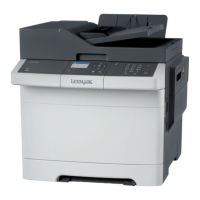The duplex ADF enables the user to create duplex scans automatically, eliminating the need to stop the scanning process
to flip the media being duplicated over. The ADF uses DC motors with encoder wheels, and a series of sensors to
determine the media’s position in the paper path during the scan process. The following steps are performed in creating
a duplex scan on the duplex ADF:
Note: The simplex ADF uses only one motor for all paper transport functions, and does not have de-skew
capabilities. The scanner control unit, on the controller board receives a command to create a scan, fax, or copy.
1 The scanner control unit, on the controller board receives a command to create a scan, fax, or copy.
2 A signal is sent to the ADF to poll the document sensor (1) to check if the media to be scanned is in the correct
position. The media must be placed in the ADF input tray so it actuates the document sensor. If the ADF document
sensor isn’t actuated, a flatbed scan is run by default.
3 If the media has actuated the document sensor, then an ADF scan is executed. At this point the pickup roller (2) on
the pick arm assembly drops and advances the paper into the ADF. To minimize the possibility of multiple sheets
being fed, a counter rotating separator roll (3) is used. After passing through pick assembly, the media actuates the
stage and interval sensors (4). Actuating these sensors determines that this will be the first side of the document
to be scanned.
4 In addition the stage sensors are used to determine and correct document skew if it is present. If the stage sensors
are actuated at different times, then the paper is slowly fed to the paper feed 1 roller. The feed motor encoder
wheel count tracks the paper location in the paper path.
5 When the paper reaches the paper feed 1 roller (5), the stationary state of the paper feed 1 roller acts as a registration
roll, causing the paper to de-skew.
6 When the encoder count reaches a certain count, the paper feed 1 roller advances the now de-skewed paper to
the paper feed 2 roller (6) and the feed sensor (7). If the paper does not actuate the feed sensor before a certain
encoder count is attained, a paper jam error is generated.
7 When the feed sensor is actuated the paper advances to the scan area (8). While the paper is advancing to the scan
area, the DC motor encoder generates a count which is stored in an on-board counter. These counts along with the
feed sensor ensure that the media is travelling at the correct speed through the scan area. The speed the document
travels through the ADF scan area is dependent on the image DPI specified by the user.
8 After a predetermined number of counts, the media reaches the scan area and the image acquisition process is
initiated. While the image acquisition process is executing, the feed sensor is being polled to determine if the trailing
edge of the media has reached the sensor.
9 Once the trailing edge of the scan media has reached the feed sensor, that sensor goes to the off position. After
the feed sensor is switched off, the image acquisition process continues for a predetermined length of time.
10 When the image acquisition process is completed, the trailing edge of the media continues to the reverse point. If
the scan job is simplex, then the media continues to the exit roller (11) and exits the ADF.
11 If the scan job is a duplex scan job, then the feed motor is reversed with a swing gear when the trailing edge of the
media reaches the reverse point. A swing gear moves the diverter gate to the down position.
12 The reversed exit roll (10) pulls the paper back into the ADF. The eject 2 roll then moves the media to the duplex
sensor. When the duplex sensor (9) is actuated, the exit roll stops. Also, the duplex sensor indicates that this is the
second side of the media to be scanned.
7527
Appendix C: Theory of operation
367

